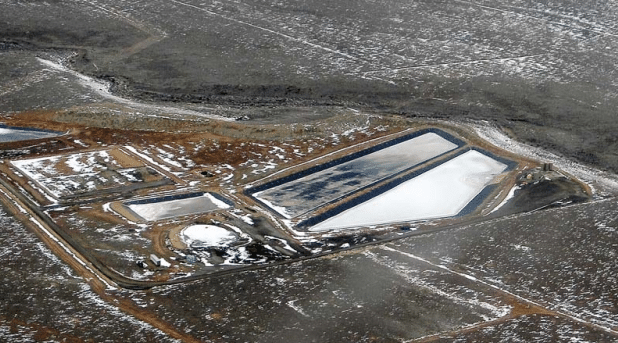For two years, residents around Whitewater, Colorado, have struggled to live with a terrible stench emanating from the Deer Creek waste disposal facility nearby. Operated by Alanco Energy Services, a subsidiary of Alanco Technologies of Scottsdale, Arizona, the facility was created expressly to profit from the waste and contaminated water produced by the oil and gas industry.
The Deer Creek waste disposal facility, located 20 miles south of Grand Junction, accepts frackwater and other hazardous wastes from oil and gas operations for a 100-mile radius around the facility. It opened in September 2012, after winning unanimous approval from the oil and gas-friendly Mesa County Commissioners, over the objection of area residents, who tried unsuccessfuly to fight the facility.
In a December 2013 news release touting the unanimous approval, Alanco bragged that their Deer Creek site and its evaporative waste ponds would provide a “’one stop shop’” for disposal of all O&G [oil and gas] waste products, including naturally-occurring radioactive material waste streams.”
Twenty four hours a day, seven days a week, truckloads of contaminated water called “produced water” from fracking operations lumber up the road to the site and dump their contents into evaporative ponds totaling 8 acres.
Alanco also operates a second disposal facility nearby which, in addition to frackwater, accepts drill cuttings, tank bottoms and radioactive contaminated filter socks.
Soon after the facility opened, area residents started complaining about foul odors coming from the frackwater ponds, followed by nosebleeds, headaches and difficulty breathing.
They told the County Commissioners of the problems at public meetings, explaining that they’ve had to curtail outdoor activities like barbecues and outdoor play, because of the stench enveloping their homes. They cannot open their windows on warm evenings, and some people were keeping their young children indoors out of fear they could be harmed by chemicals wafting through the air.
Neighbors described the stench variously as “metallic,” “mechanical,” “chemical,” and “like being behind a diesel truck as it goes up a hill.”
County Commissioners threatened to pull Alanco’s conditional use permit for the site unless they solve the odor problem.
Contentious Meeting
In response to the threat, Alanco formed a team of chemical consultants, microbiologists and suppliers, but so far have refused to disclose the names or company affiliations of any of them to area residents.
At a May 27, 2015 community meeting about the odors held at the Lands End fire station in Whitewater, an Alanco official said the company had tried “Plan A” and “Plan B” to address the problem — adding chlorine and other chemicals to the ponds to try and reduce the smell. But those treatments “weren’t as effective as we had hoped.”
But, the Alanco rep said, a treatment on May 23 had yielded “a big change.” He said he hadn’t had any more complaints since then, and proudly pronounced the problem solved.
Whitewater area residents begged to differ, however, saying that while they had had a couple of improved days, they still smelled the odor, and that it gets particularly dense after the brief, heavy rains that have been occurring throughout western Colorado in May.
One irritated neighbor at the back of the room yelled, “You said you haven’t had any complaints recently, but I complained about having to eat a burger while smelling peroxide and chemicals, so don’t be sitting there saying it’s fixed when it’s not. If you can’t fix it, then close the place. Suck it up and get it done.”
The Alanco rep said the odor problem was due to anaerobic metabolism that took hold in the bacteria in one pond and then spread to the other ponds. He struggled to try to explain a reason for the problem, but could only guess at its origins.
“We get a lot of dust here,” the Alanco representative said. “The southwest winds pick it up and when it hits the water, it sinks to the bottom and creates a living petrie dish for bacteria.”
“But didn’t you know about this condition before you built the facility?” a resident demanded to know.
The Alanco official didn’t respond.
The Alanco rep also said the problem could have been caused by “something like a zebra mussel, that came in on a truck and that we didn’t know about.”
Neighbors then questioned why Alanco didn’t know exactly what the trucks were bringing into the facility.
Another neighbor asked just what benefit the Deer Creek disposal site confers on Mesa County. The Alanco rep replied that it creates jobs in the area, but when asked how many jobs the facility provides, he revealed that it generated only three full-time positions and one part-time position.
Residents were testy during the meeting, and cited the trial-and-error, hit-or-miss style of Alanco’s treatment of the ponds. One person asked Alanco whether they had “Plans D, E and F” in place, in case the odor problem worsens again in the summer heat, like it did last year.
Neighbors also questioned Alanco’s ability to handle other emergencies at the site, like pond breaches or contaminant spills. One resident pointed out that Alanco posts no emergency procedures on its website, which is the first place they would go for information about what to do in the event of a site emergency.
Another pointed out that there is a significant difference between “allowable” and “safe” limits for the amount of contaminants or chemical constituents in the environment, and that just conforming to the “allowable” standards, as Alanco claimed they were, might not be enough to assure residents are safe. The Alanco rep had no response to this statement, either.
Struggling to wind down the meeting, Alanco officials said the next community meeting is not yet scheduled, but assured residents they plan to keep working to resolve the odor problem. The meeting ended with disgruntled residents heading home, as skeptical as ever about their problematic industrial neighbor.
Subscribe to our newsletter
Stay up to date with DeSmog news and alerts






